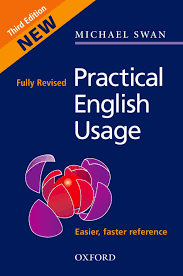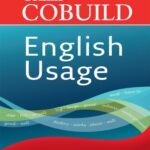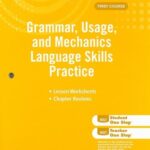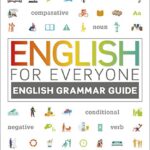Oxford Practical English Usage.600+ A-Z entries explain common problems with clear, concise information. Free eBook/Flipbook and PDF
Oxford Practical English Usage

What is Oxford Practical English Usage?
Practical English Usage is a com bined usage guide and learner’s grammar. It is intended m ainly for advanced students and teachers of English as a foreign or second language; it may also be useful to teacher trainers and m aterials writers.
It is not addressed to native speakers of English, who need a rather different
kind of reference book.
A usage guide
Usage guides deal w ith problem points: words and structures that people have difficulty with, or disagree about. English, like all languages, is full of problems for the foreign learner. Some of these points are easy to explain – for instance, the formation of questions, the difference betw een since and for, or the m eaning of after all. Other problems are more tricky, and cause difficulty even for advanced students and teachers.
How exactly is the present perfect used? When do we use past tenses to be polite? What are the differences betw een at, on and in with expressions of place? We can say a chair leg – why not a cat leg? W hen can we use
the expression do so? W hen is the used w ith superlatives? Is unless the same as if not-1. What are the differences betw een come and go, between each and every, betw een big, large and great, or betw een fairly, quite, rather and pretty? Is it correct to say There’s three more bottles in the fridge1. How do you actually say 3 x 4 = 121 And so on, and so on.
Practical English Usage is a guide to problems of this kind. It deals with over
1,000 points which regularly cause difficulty to foreign students of English. It
will be useful, for example, to a learner who is not sure how to use a particular structure, or who has made a mistake and wants to find out why it is wrong. It will also be helpful to a teacher who is looking for a clear explanation of a difficult language point. There is very full coverage of gram m ar, as well as explanations of a large num ber of com m on vocabulary problems. There are also some entries designed to clarify more general questions (e.g. formality, slang, the nature of standard English and dialects) which students and teachers may find themselves concerned with.
Problems are mostly explained in short separate entries. This makes it possible to give a clear complete treatm ent of each point, and enables the user to concentrate just on the question that he or she needs inform ation about. In longer entries, basic inform ation is generally given first, followed by more detailed explanations and discussion of more advanced points.
A complete student’s grammar
The gram m atical entries in Practical English Usage are grouped into 28 Sections, each dealing w ith a major gram m atical topic (e.g. present tenses, passives, nouns and noun phrases, prepositions, relative clauses). So the book can be used not only as a guide to particular usage problems, but also as a systematic reference gram m ar. For users who like to work in this way, each Section begins w ith one or two pages giving a general introduction to the gram m atical topic, together with a list of common mistakes that are dealt with in the entries that follow.
The grammar Sections include a good deal of inform ation about the structures used with particular words. In addition, the last three Sections of the book deal specifically w ith vocabulary questions, and include an A-Z guide to over 250 common word problems of various kinds.
Approach and style
I have tried to m ake the presentation as practical as possible. Each entry
contains an explanation of a problem, exam ples of correct usage, and (when this is useful) exam ples of typical mistakes. In some cases, an explanation may be som ew hat different from that found in m any learners’ gram m ars; this is because the rules traditionally given for certain points (e.g. conditionals or indirect speech) are not always accurate or helpful. Explanations are, as far as possible, in simple everyday language. W here it has been necessary to use gram m atical terminology, I have generally preferred to use traditional terms that are simple and easy to understand, except w here this would be seriously m isleading. Some of these term s (e.g. future tense) would be regarded as unsatisfactory by academ ic gram m arians, but I am not w riting for specialists.
There is a glossary of the term inology used in the book on pages xx-xxix.
The kind of English described The explanations deal m ainly w ith standard everyday southern British English, but contrasts betw een British and Am erican English are given detailed attention. There are also brief notes on several other varieties (e.g. Australian and Indian English). Inform ation about stylistic differences (e.g. between formal and inform al usage, or spoken and w ritten language) is provided where this is appropriate.
Correctness and rules
If people say that a form is not ‘correct’, they can m ean several different things.
They may for instance be referring to a sentence like I have seen her yesterday, which norm ally only occurs in the English of foreigners. They may be thinking of a usage like less people (instead offewer people), which is com m on in standard English but regarded as wrong by some people. Or they may be talking about forms like ain-l or ‘double negatives’, which are used in speech by m any British and American people, but which do not occur in the standard dialects and are not usually written. This book is m ainly concerned with the first kind of ‘correctness’; the differences betw een British or American English and ‘foreign’ English.
However, there is also information about cases of divided usage in standard
English, and about a few im portant dialect forms.
The rules given in this book are descriptive: they explain what actually happens in standard spoken and written English. Some usage guides give prescriptive rules – rules devised by people who feel that the language should be tidied up or protected against corruption. Such rules do not always correspond to actual usage (the rule about not using less with plurals is an example). In Practical English Usage, I avoid giving rules w hich do not describe the language as it is actually used, though I m ention their existence w here this is useful.




BROWSE THE EBOOK


IF YOU ARE INTERESTED IN BUYING THIS BOOK, CLICK ON THE BUTTON BELOW
Practical English Usage, 4th Edition Paperback with Online Access: Michael Swan’s guide to problems in English




WE DO NOT SUPPORT COPYRIGHT DISPUTES – USE ONLY FOR TEACHING AND LEARNING PURPOSES





